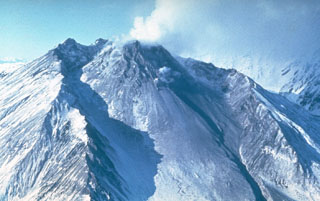Report on Bezymianny (Russia) — 30 April-6 May 2025
Smithsonian Institution / US Geological Survey
Weekly Volcanic Activity Report, 30 April-6 May 2025
Managing Editor: Sally Sennert.
Please cite this report as:
Global Volcanism Program, 2025. Report on Bezymianny (Russia) (Sennert, S, ed.). Weekly Volcanic Activity Report, 30 April-6 May 2025. Smithsonian Institution and US Geological Survey.
Bezymianny
Russia
55.972°N, 160.595°E; summit elev. 2882 m
All times are local (unless otherwise noted)
The Kamchatkan Volcanic Eruption Response Team (KVERT) reported that an explosive eruption at Bezymianny on 23 April produced ash plumes that rose 11 km (36,100 ft) a.s.l. and pyroclastic flows that descended the Vostochnaya (E) and Yuzhnaya (S) drainages. The ash cloud drifted SW and then SE as far as 900 km during 23-25 April. Following the explosions the dome continued to erupt viscous lava and small, hot avalanches of material descended the flanks. A bright thermal anomaly was visible in satellite images through 1 May. The Aviation Color Code was lowered to Yellow (the second lowest level on a four-color scale) on 29 April.
Geological Summary. The modern Bezymianny, much smaller than its massive neighbors Kamen and Kliuchevskoi on the Kamchatka Peninsula, was formed about 4,700 years ago over a late-Pleistocene lava-dome complex and an edifice built about 11,000-7,000 years ago. Three periods of intensified activity have occurred during the past 3,000 years. The latest period, which was preceded by a 1,000-year quiescence, began with the dramatic 1955-56 eruption. This eruption, similar to that of St. Helens in 1980, produced a large open crater that was formed by collapse of the summit and an associated lateral blast. Subsequent episodic but ongoing lava-dome growth, accompanied by intermittent explosive activity and pyroclastic flows, has largely filled the 1956 crater.

